Caryn’s Thoughts

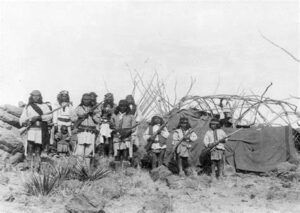 The Indians, at least the ones present in the early days of the United States, were very superstitious, and they believed that the hissing and thundering of the geysers to be voices of evil spirits. Not knowing much about the curvature of the Earth, they also regarded the mountains at the head of the river as the crest of the world. They believed that if they could make it over the summits, they would gain the happy hunting-grounds below. They believed their homes would be blessed. The Indians loved this land and felt like it was the land left to them by their fathers, who had hunted there. They didn’t want to hand it over to the white man. Nevertheless, the soldiers were duty bound to pursue the defiant warriors, to avenge the wrongs the Indians had committed while suffering under the sting of tyranny and wrong. It had been a bloody battle and just scant few of the fugitive band finally gathered at the head of the canyon known as the Grand Canyon of the Yellowstone. These few had succeeded in escaping the bullets of the soldiers, and they had courageously decided to die rather than be taken and carried away to be placed in a distant prison. This was their homeland, and they would die rather than leave it again.
The Indians, at least the ones present in the early days of the United States, were very superstitious, and they believed that the hissing and thundering of the geysers to be voices of evil spirits. Not knowing much about the curvature of the Earth, they also regarded the mountains at the head of the river as the crest of the world. They believed that if they could make it over the summits, they would gain the happy hunting-grounds below. They believed their homes would be blessed. The Indians loved this land and felt like it was the land left to them by their fathers, who had hunted there. They didn’t want to hand it over to the white man. Nevertheless, the soldiers were duty bound to pursue the defiant warriors, to avenge the wrongs the Indians had committed while suffering under the sting of tyranny and wrong. It had been a bloody battle and just scant few of the fugitive band finally gathered at the head of the canyon known as the Grand Canyon of the Yellowstone. These few had succeeded in escaping the bullets of the soldiers, and they had courageously decided to die rather than be taken and carried away to be placed in a distant prison. This was their homeland, and they would die rather than leave it again.
The brave warriors built a raft and tied it securely on the river at the foot of the upper falls. Then they reveled, for a few days, in the peace and the bounty of the area that had always belonged to them, feeling once again that it belonged to them and that maybe there was no such thing as the white men who were pursuing them relentlessly. Their time in that beautiful place was, however, short-lived, and one morning, they are aroused from peaceful sleep by the crack of rifles fire. The soldiers had found them.
With resolve, and knowing that they could not escape, the warriors boarded their raft and pushed out toward the middle of the stream. I don’t know if they were trying for the opposite shore, or if they knew what would happen next, but the current immediately grabbed the raft and held it firmly in its grasp. Some of the warriors had guns that they defiantly discharged at the soldiers. For their part, the soldiers just stood in shock as the scene unfolded in front of their horrified eyes. The soldiers didn’t even fire a single shot, but instead, watched with nothing short of dread as the raft passed into the current and was wildly tossed around, whirling faster and faster. The waves seemed to sing a “death song” as they triumphantly forced the raft closer and closer to the edge and the roar of the falls. It is hard to say if the warriors felt and fear, or if they had simply decided that death was preferred to a life in prison. Whatever they felt, was drowned as the faced the soldiers with a look of defiance, and screamed the tones of the death chant, of no less than hate and even celebration, lurched onward to their end.
In times of war, the two sides are prepared to kill, but as the raft raced toward the edge, the soldiers, as 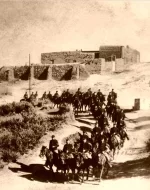
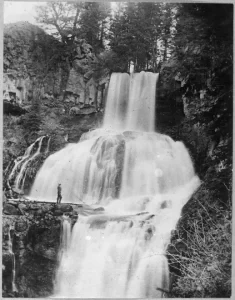 hardened as they were, could not stop their shudders as they contemplated the fate the Indians had chosen for themselves. Then, the brink was reached. The raft was pulled between the jaws of the rocks at the top of the falls. Beyond the rocks were vast walls, leading to the floor of the gulf a thousand feet below. The raft tipped toward the gulf, and with a cry of triumph, the Indians were launched over the edge into the raging falls. As the warriors fell, they were met by the brilliant colors of the rising sun. The view would have normally been considered beautiful and even peaceful, except for the horror of what was coming. Nevertheless, the warriors had decided that they would rather die than leave the land they loved, and so they died…on their own terms.
hardened as they were, could not stop their shudders as they contemplated the fate the Indians had chosen for themselves. Then, the brink was reached. The raft was pulled between the jaws of the rocks at the top of the falls. Beyond the rocks were vast walls, leading to the floor of the gulf a thousand feet below. The raft tipped toward the gulf, and with a cry of triumph, the Indians were launched over the edge into the raging falls. As the warriors fell, they were met by the brilliant colors of the rising sun. The view would have normally been considered beautiful and even peaceful, except for the horror of what was coming. Nevertheless, the warriors had decided that they would rather die than leave the land they loved, and so they died…on their own terms.
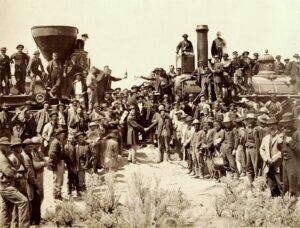 I have taken a number of train rides in my life. I love riding the trains. Some rides were very comfortable, while others are more primitive, with wooden seats, that would not be suitable for a long trip. The transcontinental train was not technically a part of the Gilded Age, when everything was luxurious, but it did feature many of the trapping of that era, and not just in the parlors of the Gilded Age magnates, but in the cars where the everyday travelers would ride too…at least in the first class cars. The cars were adorned with velvet seat cushions and gilt-framed mirrors, and the passengers feasted on antelope, trout, berries, and even champagne. Of course, not every train in 1869 was so elaborately adorned, but then the others were not the Transcontinental Train either. Still, the second-class passengers did have upholstered seats, making their trip not too bad. The third-class, or “emigrant” passengers, paid half of what the first-class passengers did, but they had to sit on benches instead of seats and bring their own food.
I have taken a number of train rides in my life. I love riding the trains. Some rides were very comfortable, while others are more primitive, with wooden seats, that would not be suitable for a long trip. The transcontinental train was not technically a part of the Gilded Age, when everything was luxurious, but it did feature many of the trapping of that era, and not just in the parlors of the Gilded Age magnates, but in the cars where the everyday travelers would ride too…at least in the first class cars. The cars were adorned with velvet seat cushions and gilt-framed mirrors, and the passengers feasted on antelope, trout, berries, and even champagne. Of course, not every train in 1869 was so elaborately adorned, but then the others were not the Transcontinental Train either. Still, the second-class passengers did have upholstered seats, making their trip not too bad. The third-class, or “emigrant” passengers, paid half of what the first-class passengers did, but they had to sit on benches instead of seats and bring their own food.
With the move west, thousands of people flocked to the Transcontinental Railroad beginning in 1869. The 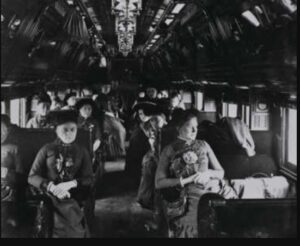 railroad, which stretched nearly 2,000 miles between Iowa, Nebraska, and California, reduced travel time across the West from about six months by wagon or 25 days by stagecoach to just four days. That was an amazing change, and it meant that families that moved west might actually be able to see loved ones they left behind. Prior to that time, moving west could mean saying goodbye forever to the family members who stayed behind. The Transcontinental Railroad represented both the height of modern technology and the tempting possibility of unrestricted travel, although it might take time for people to feel safe with train travel.
railroad, which stretched nearly 2,000 miles between Iowa, Nebraska, and California, reduced travel time across the West from about six months by wagon or 25 days by stagecoach to just four days. That was an amazing change, and it meant that families that moved west might actually be able to see loved ones they left behind. Prior to that time, moving west could mean saying goodbye forever to the family members who stayed behind. The Transcontinental Railroad represented both the height of modern technology and the tempting possibility of unrestricted travel, although it might take time for people to feel safe with train travel.
While the train made it possible to go west much quicker, it wasn’t cheap, nor was it as fast as future forms of travel would be. The first passenger train on the line took 102 hours to travel from Omaha, Nebraska to San Francisco, California, and a first-class ticket cost $134.50, which is about $2,700 today…hardly affordable for a 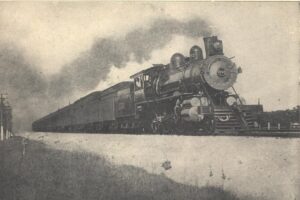 casual trip. Families might save for years to be able to visit their child, and often only one family member could go at a time. The places the train traveled, were not filled with cities, towns, or even very many homesteads, because at the time, the areas through which the train had been built were not yet open to large numbers of white settlers. In fact, millions of acres of the land the new railroad traversed had belonged to the Native American people, but the US Congress had granted the land to railroad companies. The Native Americans saw this as an intrusion, knowing that behind it would come a wave of white settlers. Nevertheless, the trains and the white man were here to stay.
casual trip. Families might save for years to be able to visit their child, and often only one family member could go at a time. The places the train traveled, were not filled with cities, towns, or even very many homesteads, because at the time, the areas through which the train had been built were not yet open to large numbers of white settlers. In fact, millions of acres of the land the new railroad traversed had belonged to the Native American people, but the US Congress had granted the land to railroad companies. The Native Americans saw this as an intrusion, knowing that behind it would come a wave of white settlers. Nevertheless, the trains and the white man were here to stay.

 Recently, in a Mount Saint Helens-esk alert level increase, Mount Spurr, a stratovolcano in the Aleutian Arc of Alaska, made its entrance into the spotlight. The volcano isn’t about to explode in the same way Mount Saint Helens was, but it does appear to be about to erupt again. Mount Spurr was named after United States Geological Survey geologist and explorer Josiah Edward Spurr, who led an expedition to the area in 1898. Mount Spurr is currently rated at a Level of Concern Color Code Yellow by the Alaska Volcano Observatory (AVO). It’s obvious that Mount Spurr has an active history, because it is aboriginally known by the Dena’ina Athabascan name K’idazq’eni, which literally means “that which is burning inside.”
Recently, in a Mount Saint Helens-esk alert level increase, Mount Spurr, a stratovolcano in the Aleutian Arc of Alaska, made its entrance into the spotlight. The volcano isn’t about to explode in the same way Mount Saint Helens was, but it does appear to be about to erupt again. Mount Spurr was named after United States Geological Survey geologist and explorer Josiah Edward Spurr, who led an expedition to the area in 1898. Mount Spurr is currently rated at a Level of Concern Color Code Yellow by the Alaska Volcano Observatory (AVO). It’s obvious that Mount Spurr has an active history, because it is aboriginally known by the Dena’ina Athabascan name K’idazq’eni, which literally means “that which is burning inside.”
Located 81 miles west of Anchorage and northeast of Chakachamna Lake, Mount Spurr is the highest volcano of the Aleutian Arc. It has a large stratocone at the center of a roughly 3.1 miles horseshoe-shaped caldera that is open to the south. The caldera was formed by a Mount Saint Heles like “late-Pleistocene or early Holocene sector collapse and associated pyroclastic flows that destroyed an ancestral Spurr volcano. The debris avalanche traveled more than 15.5 miles to the southeast, and the resulting deposit contains blocks as large as 330 feet in diameter. Several ice-carved post-caldera domes lie in the caldera.” The present-day Mount Spurr is 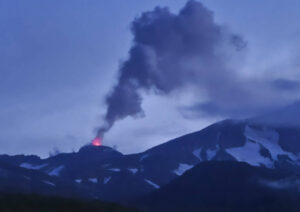 the highest of the post-caldera. So much change can take place as the events of a volcano unfold. The regrown summit peak of Mount Spurr experienced a heating event in 2004 which created a small crater lake. Then, by 2008, the summit crater had cooled enough to have begun to have accumulated significant amounts of snow again. As with any seismically active mountain, the youngest post-caldera dome, Crater Peak has grown to 7,575 feet. “It was formed at the breached southern end of the caldera about 2.0 miles south of Spurr, has been the source of about 40 identified Holocene tephra layers. Spurr’s two historical eruptions, from Crater Peak in 1953 and 1992, deposited ash on the city of Anchorage. Crater Peak has a summit crater that is itself slightly breached along the south rim; the north wall of the crater exposes the truncated remains of an older dome or lava lake. Before the 1992 eruption, a small crater lake occupied the bottom of Crater Peak’s crater.” The problem with volcanoes, especially so close to the major trans-Pacific aviation routes is that an eruption of this volcano can significantly disrupt air travel. Volcanic ash can cause jet engines to fail.
the highest of the post-caldera. So much change can take place as the events of a volcano unfold. The regrown summit peak of Mount Spurr experienced a heating event in 2004 which created a small crater lake. Then, by 2008, the summit crater had cooled enough to have begun to have accumulated significant amounts of snow again. As with any seismically active mountain, the youngest post-caldera dome, Crater Peak has grown to 7,575 feet. “It was formed at the breached southern end of the caldera about 2.0 miles south of Spurr, has been the source of about 40 identified Holocene tephra layers. Spurr’s two historical eruptions, from Crater Peak in 1953 and 1992, deposited ash on the city of Anchorage. Crater Peak has a summit crater that is itself slightly breached along the south rim; the north wall of the crater exposes the truncated remains of an older dome or lava lake. Before the 1992 eruption, a small crater lake occupied the bottom of Crater Peak’s crater.” The problem with volcanoes, especially so close to the major trans-Pacific aviation routes is that an eruption of this volcano can significantly disrupt air travel. Volcanic ash can cause jet engines to fail.
On July 26, 2004, the AVO raised the “Color Concern Code” at Spurr from green to yellow due to an increasing number of earthquakes. When it comes to volcanoes, earthquakes beneath the surface may indicate the movement of magma preceding a volcanic eruption. Of course, the earthquakes might also die out without an eruption. In the first week of August 2004, the AVO reported the presence of a collapse pit, filled with water forming a new crater lake, in the ice and snow cover on the summit. It is thought that this lake might have been caused by an increase in heat flow through the summit lava dome. A debris flow was observed in webcam 
 images, as well as by a nearby pilot on May 3, 2005. A subsequent overflight revealed that much of the sitting pond within the melt hole had drained away, leaving a cauldron of notable depth. On October 23, 2024, the alert level for Mount Spurr was again raised to yellow (advisory), because of an increase in seismic activity, which is what reminds me of the Mount Saint Helens alerts.
images, as well as by a nearby pilot on May 3, 2005. A subsequent overflight revealed that much of the sitting pond within the melt hole had drained away, leaving a cauldron of notable depth. On October 23, 2024, the alert level for Mount Spurr was again raised to yellow (advisory), because of an increase in seismic activity, which is what reminds me of the Mount Saint Helens alerts.
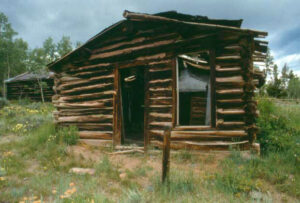
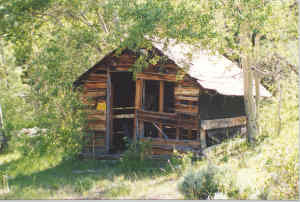 Ghost towns dot the landscape of the United States, including Hamilton City, Wyoming, which is also known as Miner’s Delight. The town is located in Fremont County, on the southeastern tip of the Wind River Range. Miner’s Delight was in a prosperous area during the mining boom in the American West in the second half of the 19th century. It was actually a “sister city” of Atlantic City and South Pass City, however they are more well known and have fared better that Miner’s Delight. Nevertheless, a few buildings still stand today as a reminder of an era in Wyoming’s past history.
Ghost towns dot the landscape of the United States, including Hamilton City, Wyoming, which is also known as Miner’s Delight. The town is located in Fremont County, on the southeastern tip of the Wind River Range. Miner’s Delight was in a prosperous area during the mining boom in the American West in the second half of the 19th century. It was actually a “sister city” of Atlantic City and South Pass City, however they are more well known and have fared better that Miner’s Delight. Nevertheless, a few buildings still stand today as a reminder of an era in Wyoming’s past history.
Like most western mining towns, Miner’s Delight went through several boom-bust periods. With the boom-bust periods came corresponding increases and declines in its population. In 1868, gold was in the area, and by 1870, at the height of the mine’s operations. At that point, the population in Hamilton City was 75, forty of whom were miners. The original boom of mining activity “busted” from 1872 to 1874. Then, by the 1880s a new era of economic prosperity had dawned. There were smaller booms in 1907 and in 1910, and even during the Great Depression. The town was inhabited as late as 1960. By 2015, there were no residents in the town.
Jonathan Pugh founded the Miners Delight mine, which was located about a quarter mile west of the town then known as Hamilton City. The normal boom and bust periods followed, eventually leading to the mine completely shutting down in March 1882. The mine was not used again until after the turn of the 20th century. Then, two brief boom periods in 1907 and in 1910, were in relation to mining operations.
There was one famous incident involving Miner’s Delight which occurred there in March 1893. The incident was widely covered in the press at the time, which was in Cheyenne and was read throughout Wyoming. It came to be known as “the brass lock service mystery.” The postmaster of Miner’s Delight, James “Jimmy” Kime had attempted to ship eight registered letters via the Rawlins and Northwestern’s line’s Lander-to-Rawlins stagecoach to the Postmaster in Rawlins using the “brass lock service.” The Post Office’s “brass lock service” utilized canvas pouches, which were locked with brass locks. The only persons that had a key were the Postmasters along the stage line. When Kime’s pouch reached its destination in Rawlins some 120 miles to the southeast, however, the postmaster there discovered that someone had cut the pouch and stolen all the registered letters. The crime was unheard of
The US Postal inspectors investigated the matter for many months. During that time, a number of other related thefts of various valuables on the line from the locked pouches occurred. Finally, they arrested Postmaster John Gatlin of the Myersville Station near today’s Jeffrey City, Wyoming, along with his wife Stella. The couple was tried in Laramie City and the trial into the Fall of 1893. At that point, charges against John Gatlin were dropped, after Stella Gatlin confessed to stealing the items, due to what she claimed to be her illness of kleptomania. Her affidavit stated that “she had struggled for years to overcome the mania, while keeping it a secret from her husband.” On November 25, 1893, the jury found Mrs. Gatlin guilty. Two days later, she was taken to the Laramie Prison, where she was registered as Prisoner #150, the first woman to be imprisoned there after being convicted of a federal crime in Wyoming. Following a period of “good conduct” she was released early in December 1894, and following her departure, prison officials added a special new wing exclusively for women, with individual cells and a toilet.
Today, the ghost town at Miner’s Delight which eventually went by its nickname, stands as a testament to the 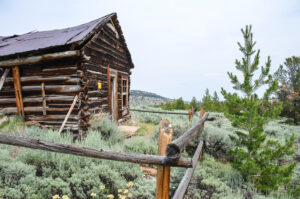
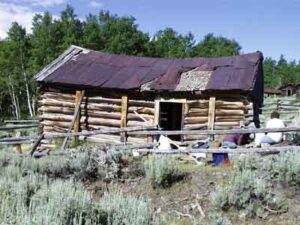 passage of time and provides historians and tourists with a peek at early Wyoming life and the gold mining culture. There are still seventeen structures, including seven cabins, one saloon, one meat house, one shop or barn, one shaft house, one pantry, one cellar, three privies, and a corral on the property. All of the buildings are constructed of logs or unfinished lumber.
passage of time and provides historians and tourists with a peek at early Wyoming life and the gold mining culture. There are still seventeen structures, including seven cabins, one saloon, one meat house, one shop or barn, one shaft house, one pantry, one cellar, three privies, and a corral on the property. All of the buildings are constructed of logs or unfinished lumber.
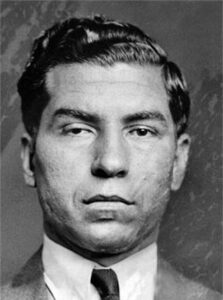
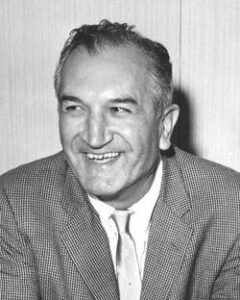 The establishment of prohibition, while originally designed to be a good thing, actually made criminals out of some people, both those who liked to have a drink and those who sold and made the alcohol. By 1931, the mob had organized. After a series of power struggles and murders, mobster Charles “Lucky” Luciano established the “Commission,” a governing body headed by five New York City crime families. Thus began four decades under the rule of the “Five Families” using tactics like loansharking, extortion, and labor union infiltration to influence and profit from a range of businesses. “They didn’t rob banks…they didn’t have to,” says Selwyn Raab, author of Five Families: The Rise, Decline, and Resurgence of America’s Most Powerful Mafia Empires. “They
The establishment of prohibition, while originally designed to be a good thing, actually made criminals out of some people, both those who liked to have a drink and those who sold and made the alcohol. By 1931, the mob had organized. After a series of power struggles and murders, mobster Charles “Lucky” Luciano established the “Commission,” a governing body headed by five New York City crime families. Thus began four decades under the rule of the “Five Families” using tactics like loansharking, extortion, and labor union infiltration to influence and profit from a range of businesses. “They didn’t rob banks…they didn’t have to,” says Selwyn Raab, author of Five Families: The Rise, Decline, and Resurgence of America’s Most Powerful Mafia Empires. “They  did all these more elegant, sophisticated crimes, because they paid more and there was less danger.” The five mob families established or basically took over a lot of different operations. They especially ran gambling and drug trafficking rings, but they also held controlling interest in construction and transportation companies.
did all these more elegant, sophisticated crimes, because they paid more and there was less danger.” The five mob families established or basically took over a lot of different operations. They especially ran gambling and drug trafficking rings, but they also held controlling interest in construction and transportation companies.
The Five Families…Genovese, Bonanno, Lucchese, Gambino and Colombo…were immigrants from Italy, particularly Sicily. Some of these were not new to the world of crime. They already had ties to Sicilian crime families, who operated according to a code of honor known as omertà…”a rule or code that prohibits speaking or divulging information about certain activities, particularly those related to criminal organizations. Omertà originated in Italy, specifically Sicily, and is often associated with the Mafia, where it represents a vow of silence regarding criminal activities and cooperation with authorities.” Because of their ties, the Five Families incorporated the concept of omertà 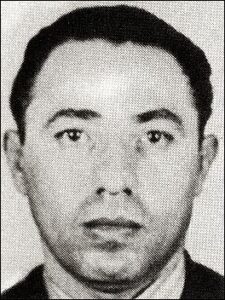
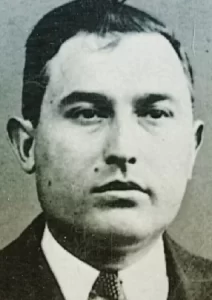 into the Commission. That effectively prohibited mobsters from ratting out members of their own family, as well as other families on the Commission…and it worked for a while.
into the Commission. That effectively prohibited mobsters from ratting out members of their own family, as well as other families on the Commission…and it worked for a while.
While the Five Families spent time in power, their influence diminished after the United States passed the 1970 Racketeer Influenced and Corrupt Organizations Act (RICO Act), which gave the government new ways to prosecute organized crime. The effectiveness of the act led mobsters to break omertà and become informants, and it even resulted in one boss flipping on his family. It is a matter of survival I guess, and apparently, while blood is thicker than water, self-preservation tops them both.
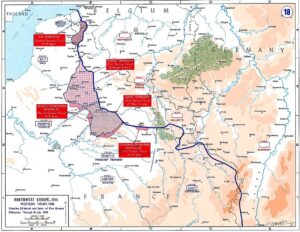
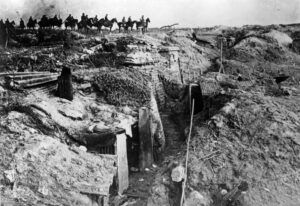 A series of German attacks along the Western Front during the First World War, beginning on March 21, 1918, known as the German Spring offensive, was also known as the Ludendorff offensive or Kaiserschlacht, which translates to Kaiser’s Battle. When the Americans entered World War I, in April 1917, the Germans knew that their days were numbered. It was decided that there was really only one way to have a chance of defeating the Allies, and that was an attack that would take place before the United States could ship soldiers across the Atlantic and fully deploy its resources. The German Army gained a temporary advantage in numbers as nearly 50 divisions had been freed by the Russian defeat and withdrawal from the war in the Treaty of Brest-Litovsk.
A series of German attacks along the Western Front during the First World War, beginning on March 21, 1918, known as the German Spring offensive, was also known as the Ludendorff offensive or Kaiserschlacht, which translates to Kaiser’s Battle. When the Americans entered World War I, in April 1917, the Germans knew that their days were numbered. It was decided that there was really only one way to have a chance of defeating the Allies, and that was an attack that would take place before the United States could ship soldiers across the Atlantic and fully deploy its resources. The German Army gained a temporary advantage in numbers as nearly 50 divisions had been freed by the Russian defeat and withdrawal from the war in the Treaty of Brest-Litovsk.
As parts of the German Spring offensive, there were four separate offensives. They were codenamed Michael, Georgette, Gneisenau, and Blücher-Yorck. The main attack was Michael, which was intended to break through the Allied lines, and outflank the British forces. The British forces held the front from the Somme River to the English Channel. The ultimate goal was to defeat the British Army. Once that was achieved, it was hoped that the French would seek armistice terms. The other offensives were secondary to Michael and were designed to divert Allied forces from the main offensive effort on the Somme. The Germans really had no clear objective established before the start of the offensives and once the operations were underway, the targets of the attacks were constantly changed, depending on the tactical situation. It was clearly not well planned.
Nevertheless, the Germans began advancing, and immediately struggled to maintain the momentum, mostly due to logistical issues. The fast-moving stormtrooper units could not carry enough food and ammunition to sustain themselves for long, and the army could not move in supplies and reinforcements fast enough to assist them. It left them wide open to failure. For their part, the Allies concentrated their main forces in the essential areas, such as the approaches to the Channel Ports and the rail junction of Amiens. The areas considered strategically worthless ground, which had been devastated by years of conflict, were left lightly defended. The danger of a German breakthrough passed within a few weeks, although related fighting continued until July.
While largely unsuccessful, the German Army, nevertheless made the deepest advances either side had made on the Western Front since 1914. They re-took much ground that they had lost in 1916–17 and took some ground that they had not yet controlled. I suppose that could have been considered at least a partial success, but despite these apparent successes, the Germans also suffered heavy casualties in return for land that was of little strategic value and hard to defend. In the end, the offensive failed to deliver a blow that could save Germany from defeat, meaning it came at such a significant cost to the Germans that it was basically a defeat. 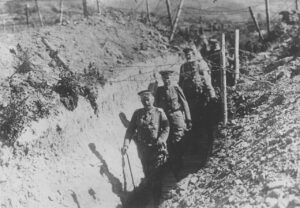
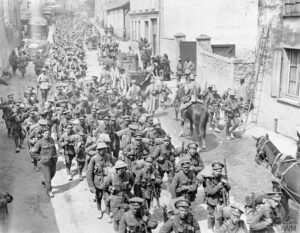 In July 1918, the Allies regained their numerical advantage with the arrival of American troops and by August, they used this and improved tactics to launch a counteroffensive. The ensuing Hundred Days Offensive resulted in the Germans losing all of the ground that they had taken in the Spring Offensive, the collapse of the Hindenburg Line, and the capitulation of Germany that November. They didn’t stand a chance.
In July 1918, the Allies regained their numerical advantage with the arrival of American troops and by August, they used this and improved tactics to launch a counteroffensive. The ensuing Hundred Days Offensive resulted in the Germans losing all of the ground that they had taken in the Spring Offensive, the collapse of the Hindenburg Line, and the capitulation of Germany that November. They didn’t stand a chance.
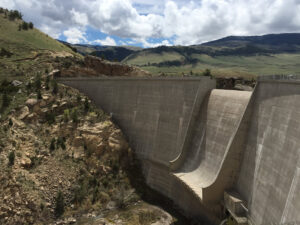
 When a dam is built, the purpose is to create a reservoir, thereby allowing for the accumulated water to be used to create irrigation for local farmers. In theory, that was the plan for the dam in Hot Springs County, Wyoming that would become known as Anchor Dam, and the resulting “reservoir” to be nicknamed “the reservoir that wouldn’t hold water” and occasionally, “boondoggle.” The dam is located 35 miles west of Thermopolis, Wyoming.
When a dam is built, the purpose is to create a reservoir, thereby allowing for the accumulated water to be used to create irrigation for local farmers. In theory, that was the plan for the dam in Hot Springs County, Wyoming that would become known as Anchor Dam, and the resulting “reservoir” to be nicknamed “the reservoir that wouldn’t hold water” and occasionally, “boondoggle.” The dam is located 35 miles west of Thermopolis, Wyoming.
The US Bureau of Reclamation built the dam in the 1950s. It was intended to provide a reliable supply of irrigation water, but after three years and $3.4 million spent on construction, it became clear that the geology of the area would not allow the reservoir to fill. After more than a decade of continuing attempts at remediation, the final cost of the dam topped $7 million, and its reservoir still holds very little water. The concrete thin-arch dam was completed in 1960 by the United States Bureau of Reclamation as a water storage project. The 208-foot-high dam structure impounds the water of the South Fork of Owl Creek, with the spillway designed as an unnecessary central overflow. Owl Creek rises in the Absaroka Mountains of northwestern Wyoming, and it was the site of early agriculture in the area. As homesteaders settled the region in the 1890s, it would become Hot Springs County. No area can support agriculture or livestock without water, so they knew something would have to be done. Ranchers used irrigation ditches to bring water from Owl Creek to pastures or to help grow livestock feed crops like alfalfa.
As construction began, the crews discovered “solution cavities” in the bedrock forced the re-positioning and re-configuration of the dam, causing delays and added expense. Solution caves or cavities are formed by the dissolution of rock along and adjacent to joints, fractures, and faults. These cavities are created by water passing through soluble rocks, leading to underground cavities and cave systems. The same karst solution cavities prevented Anchor Reservoir from filling its design capacity of 17,400 acre-feet. The reservoir has never been full. Since the dam was constructed, more than 50 sinkholes had been identified in the underlying Chugwater Formation geology of the reservoir basin. Some of the sinkholes were 30 feet in diameter and 35 feet deep. The site’s lack of “hydraulic integrity” was well known to Bureau scientists before and during construction, which begs the question…why was this project ever approved?
Bureau of Reclamation policies mandated that the Owl Creek farmers must organize an irrigation district, which would oversee distributing water to members and collecting payment. This was not well received, and a number of farmers in the area did not want to join, for two reasons. First, not everyone thought they needed the extra water, and they thought that their business would suffer if had recurring repayment costs for the project. Under Wyoming’s “first-in-time-first-in-rights” system of water law, farmers and ranchers with water rights filed earlier in time are allowed to take all the water they are entitled to before their neighbors with later rights get any. On Owl Creek, the farmers and ranchers who joined later and therefore had lower priority water rights tended to favor the proposed reservoir.
The Bureau of Reclamation rule that farmers getting project water could not own more than 160 acres, or 320 if married, was a source of contention, however. This rule was designed with the small family farm on fertile soil in mind. In the high altitude, short season, arid Owl Creek Mountains, 320 acres was nowhere near enough for cattle ranching, meaning that the rancher would not contribute. Efforts by local dam proponents to force reluctant ranchers to join the irrigation district prompted a series of lawsuits that held up progress on Anchor Dam until 1954. In 1954, Wyoming’s US senator, Frank Barrett, succeeded in having Anchor Dam exempted 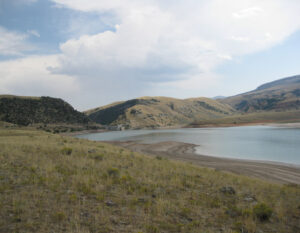
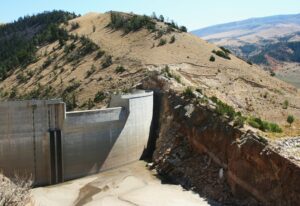 from the acreage limit. Immediately, a group of ranchers changed their minds and joined the irrigation district. With that, the Bureau of Reclamation began seriously planning for construction. Nevertheless, it was all for not, because in the end, the reservoir only filled enough to provide some irrigation benefit through July and August of each season, as it still is today. The Anchor dam is still operated by the local Owl Creek Irrigation District.
from the acreage limit. Immediately, a group of ranchers changed their minds and joined the irrigation district. With that, the Bureau of Reclamation began seriously planning for construction. Nevertheless, it was all for not, because in the end, the reservoir only filled enough to provide some irrigation benefit through July and August of each season, as it still is today. The Anchor dam is still operated by the local Owl Creek Irrigation District.
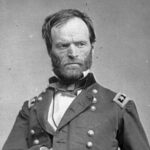
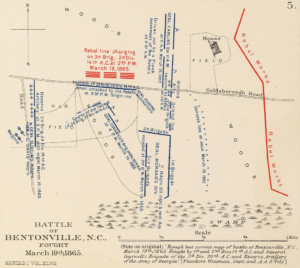 As one side of a war begins to lose the battle to the other side, the army of the losing side, really begins to weaken. While the Battle of Bentonville was not the end of the Civil War, it was on the downhill run to the end. On March 19, 1865, at the Battle of Bentonville, North Carolina, Confederate General Joseph Johnston made a desperate attempt to stop Union General William T Sherman’s drive through the Carolinas. Unfortunately for Johnston, his bedraggled force couldn’t stop the advance of Sherman’s mighty army. Sherman’s men were well supplied and strong.
As one side of a war begins to lose the battle to the other side, the army of the losing side, really begins to weaken. While the Battle of Bentonville was not the end of the Civil War, it was on the downhill run to the end. On March 19, 1865, at the Battle of Bentonville, North Carolina, Confederate General Joseph Johnston made a desperate attempt to stop Union General William T Sherman’s drive through the Carolinas. Unfortunately for Johnston, his bedraggled force couldn’t stop the advance of Sherman’s mighty army. Sherman’s men were well supplied and strong.
Sherman had taken a month off following his famous March to the Sea in late 1864. He stopped for a little rest and relaxation in Savannah, Georgia. Following his time off, Sherman turned north into the Carolinas. As he went, he literally destroyed everything in his path. It was his plan to demoralize the South and so bring the end of the war. Sherman left Savannah with 60,000 men divided into two wings, capturing Columbia and South Carolina, in February. Then he continued towards Goldsboro, North Carolina, where he planned to meet up with another army coming from the coast. His plan was to march to Petersburg, Virginia, where he would join General Ulysses S Grant and crush the army of Robert E Lee, the largest remaining Confederate force.
It was Sherman’s assumption that the Rebel forces in the Carolinas were too thinly spread to offer any much resistance, but Johnston had managed to put 17,000 soldiers together and proceeded to attack one of Sherman’s wings at Bentonville on March 19th. The attack was a surprise to the Yankees, and for a time, they were driven back. Then, a Union counterattack halted the advance and darkness halted the fighting. The next day, Johnston managed to establish a strong defensive position, where he waited and hoped for a Yankee assault. As more Union troops arrived, Sherman had a nearly three to one advantage over Johnston. When a Union force threatened to cut off the Rebel’s only line of retreat on March 21st, Johnston withdrew northward.
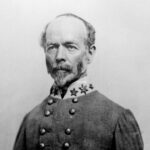
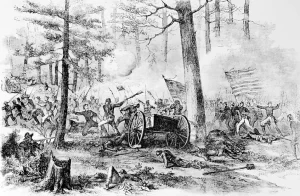
In the battles, the Union lost 194 men who were killed, 1,112 who were wounded, and they had 221 missing. The Confederates lost some 240 men who were killed, 1,700 who were wounded, and they had 1,500 missing. Johnston wrote to Lee concerning Sherman, that, he couldn’t do anything more than annoy him. Knowing that he had lost, just one month later, Johnston surrendered his army to Sherman.
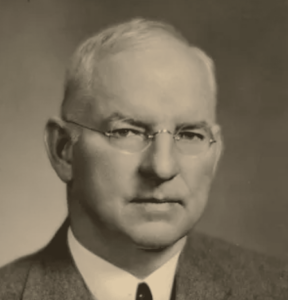
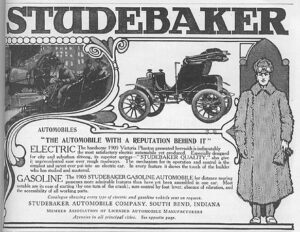 Over the years, a number of automobile makers have come and gone. Their technology likely became outdated, and the next big thing came on the scene. Such was the fate of the makers of the Studebaker on March 18, 1933. At that point, they were heavily in debt, and it seemed there was no way out. The company went into receivership. As sometimes happens, the company’s president, Albert Erskine, resigned and later that year committed suicide. The company rebounded…for a time, and perhaps if Erskine had lived, he could have brought it back to life again. In the end, Studebaker eventually rebounded from its financial troubles, but it could not sustain itself again, and so, shut down the assembly line, and abandoned the automobile business entirely in 1966.
Over the years, a number of automobile makers have come and gone. Their technology likely became outdated, and the next big thing came on the scene. Such was the fate of the makers of the Studebaker on March 18, 1933. At that point, they were heavily in debt, and it seemed there was no way out. The company went into receivership. As sometimes happens, the company’s president, Albert Erskine, resigned and later that year committed suicide. The company rebounded…for a time, and perhaps if Erskine had lived, he could have brought it back to life again. In the end, Studebaker eventually rebounded from its financial troubles, but it could not sustain itself again, and so, shut down the assembly line, and abandoned the automobile business entirely in 1966.
Studebaker Corporation started up in 1852, not as an automobile company, but to make wagons. Brothers Henry and Clement Studebaker opened a blacksmith shop in South Bend, Indiana that year. Their work was of good quality, and they eventually became a leading manufacturer of horse-drawn wagons, even suppling wagons to the US Army during the Civil War. As with the auto industry, the wagon industry began to fold, so Studebaker Corporation entered America’s blossoming auto industry, launching an electric car in 1902 and a gas-powered vehicle two years later that was marketed under the name Studebaker-Garford. Who knew that they could have actually been s forward thinking in 1902. Electric cars have been around longer than we might 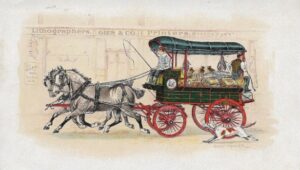 have thought. Studebaker partnered with other automakers and began selling gas-powered cars under its own name in 1913, while continuing to make wagons until 1920, when that market dried up.
have thought. Studebaker partnered with other automakers and began selling gas-powered cars under its own name in 1913, while continuing to make wagons until 1920, when that market dried up.
Erskine was born in 1871 and took over as president of Studebaker Corporation 1915. Under his leadership, the company acquired luxury automaker Pierce-Arrow in the late 1920s and launched the affordably priced but short-lived Erskine and Rockne lines, which was named for the famous University of Notre Dame football coach, before his death in a plane crash in 1931. Rockne was paid to give talks at auto conventions and dealership events. The Great Depression hit Studebaker Corporation hard and in March 1933 it was forced into bankruptcy. Erskine was also hit hard by the Great Depression, and his great personal debt and health problems caused him to kill himself on July 1, 1933.
After Erskine’s death, the company went under new management, and they were able to get the company back on track. The Rockne brand in July 1933, and Pierce-Arrow was sold as well. In January 1935, the new Studebaker Corporation was incorporated. Raymond Loewy began working for Studebaker in the late 1930s. Loewy was a French-born industrial designer. He created iconic and popular models including the bullet-nosed 1953 Starliner and Starlight coupes and the 1963 Avanti sports coupe. It looked like the company might pull out of their funk.
Unfortunately, by the mid-1950s, Studebaker had to face the fact that they just didn’t have the resources of its Big Three competitors, so they merged with automaker Packard. Nevertheless, they continued to have financial 
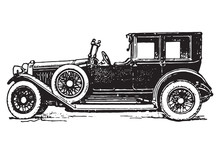 troubles. By the late 1950s, the Packard brand was dropped. In December 1963, Studebaker closed the South Bend plant. This ended the production of its cars and trucks in America. After the US closure, the company’s Hamilton, Ontario, facilities remained in operation until March 1966. Finally, after 114 years in business, Studebaker shut its doors for good.
troubles. By the late 1950s, the Packard brand was dropped. In December 1963, Studebaker closed the South Bend plant. This ended the production of its cars and trucks in America. After the US closure, the company’s Hamilton, Ontario, facilities remained in operation until March 1966. Finally, after 114 years in business, Studebaker shut its doors for good.

 Irish blessings have a long history in Ireland. They have served as protections from harm, bringers of good luck, and personal blessings for individuals and families. The Irish blessing is deeply entwined with Ireland’s cultural and spiritual heritage, offering comfort, hope, and wisdom. As a Christian, I don’t believe in luck, but I fully understand blessings. I believe all blessings come for our Father above. My favorite Saint Patrick’s Day blessing is “May your blessings outnumber the shamrocks that grow, and may trouble avoid you wherever you go.” Being part Irish, I also love Saint Patrick’s Day, which is not just about green beer, Corned Beef and Cabbage, or pinching those who forget to wear the traditional green. Saint Patrick was a real person and the patron saint of Ireland. Taken there as a slave, he became a priest bringing Christianity to Ireland.
Irish blessings have a long history in Ireland. They have served as protections from harm, bringers of good luck, and personal blessings for individuals and families. The Irish blessing is deeply entwined with Ireland’s cultural and spiritual heritage, offering comfort, hope, and wisdom. As a Christian, I don’t believe in luck, but I fully understand blessings. I believe all blessings come for our Father above. My favorite Saint Patrick’s Day blessing is “May your blessings outnumber the shamrocks that grow, and may trouble avoid you wherever you go.” Being part Irish, I also love Saint Patrick’s Day, which is not just about green beer, Corned Beef and Cabbage, or pinching those who forget to wear the traditional green. Saint Patrick was a real person and the patron saint of Ireland. Taken there as a slave, he became a priest bringing Christianity to Ireland. 
In fact, in Ireland, the day is not a party day. It’s actually a religious holiday, similar to Christmas and Easter. Things have changed some over the years, and these days you can find Saint Patrick’s Day parades, shamrocks, and green Guinness beer in Ireland, but it’s mostly there for the tourists who think that is the right way to celebrate the day. The Irish people know the truth, however. Until 1970, Irish laws mandated that the pubs be closed on Saint Patrick’s Day, making it very different from the American way of celebrating the day. It just like our oven Independence Day, which doesn’t mean the same thing to the Irish either. Every nation has its own tradition, and its own way of celebrating them. For that matter, even the different families celebrate the tradition differently. In fact, in Chicago, they actually dye the Chicago River green for the holiday, and inevitably, someone has to take a dip into the green water to celebrate the day. The river really is a cool sight in emerald green.

 Some people don’t do much, besides making sure they have some green on, and some like to almost hide their green, because if someone pinches you, and you have green on (in plain sight, of course) the rule is that you get to pinch them back. In our house, when I was growing up, we loved the pinching game for not wearing green, and we might just as easily pinch someone who fooled us, by wearing the tiniest bit of green, making us prime candidates for that revenge pinch. No matter how you celebrate, here’s wishing you a blessed and happy Saint Patrick’s Day!!
Some people don’t do much, besides making sure they have some green on, and some like to almost hide their green, because if someone pinches you, and you have green on (in plain sight, of course) the rule is that you get to pinch them back. In our house, when I was growing up, we loved the pinching game for not wearing green, and we might just as easily pinch someone who fooled us, by wearing the tiniest bit of green, making us prime candidates for that revenge pinch. No matter how you celebrate, here’s wishing you a blessed and happy Saint Patrick’s Day!!

